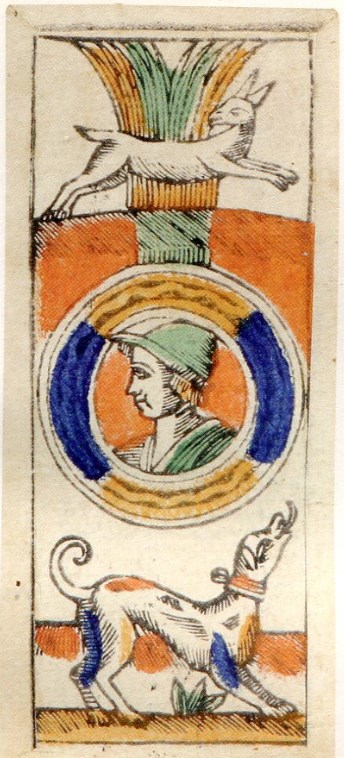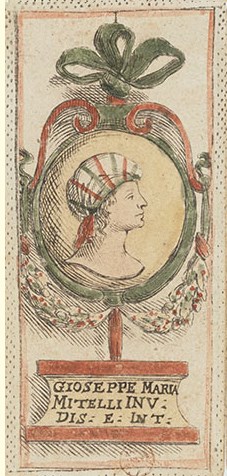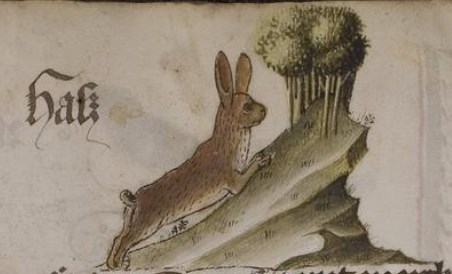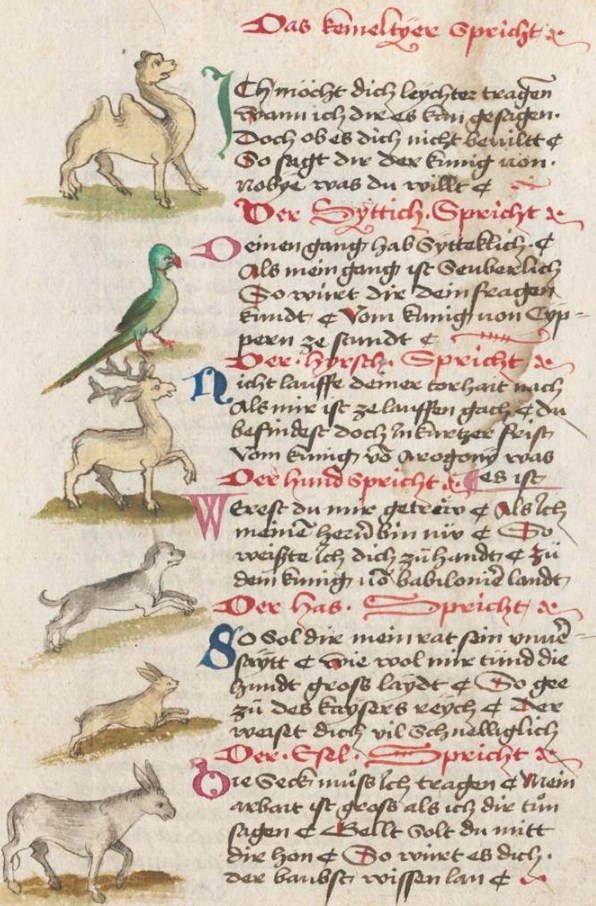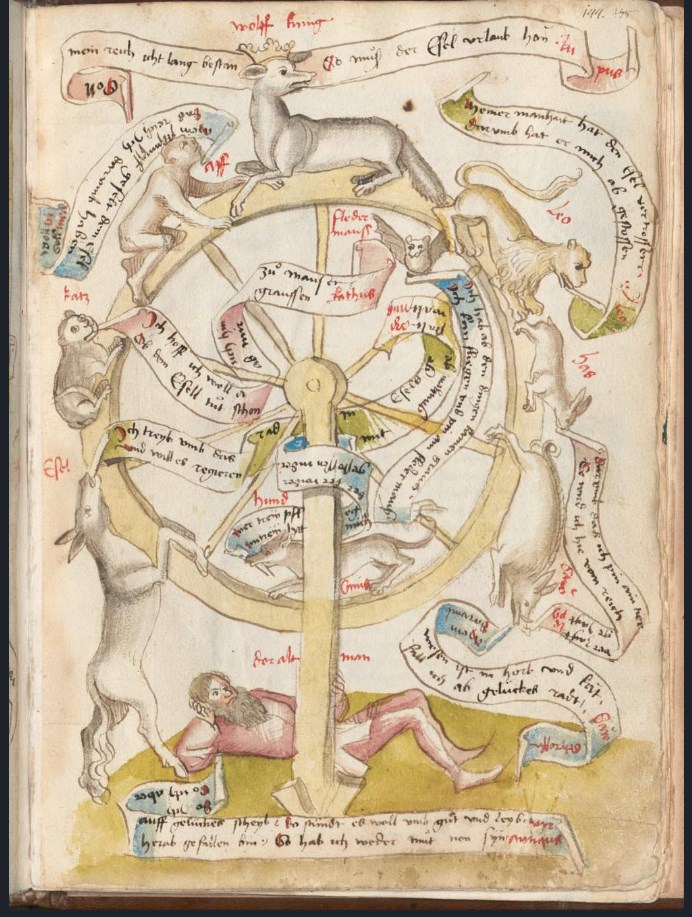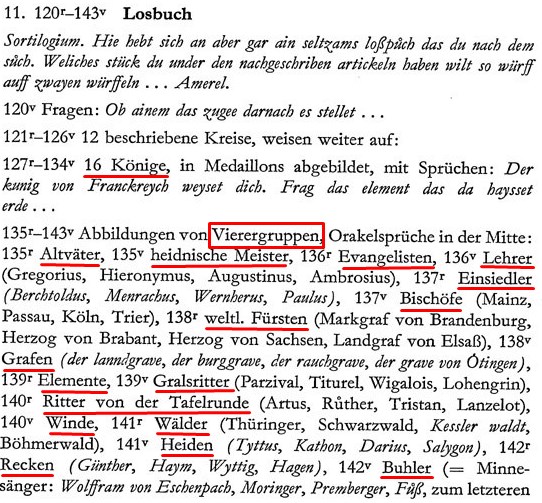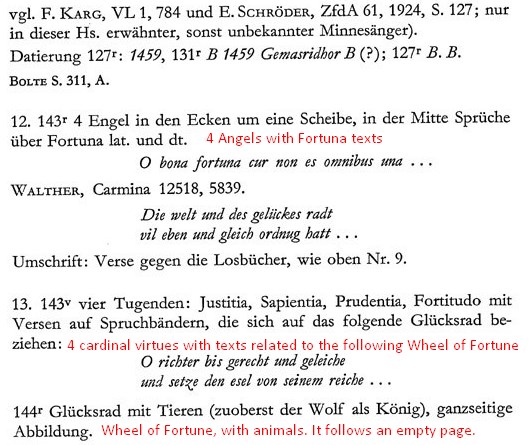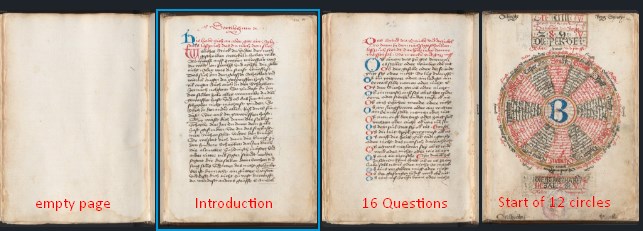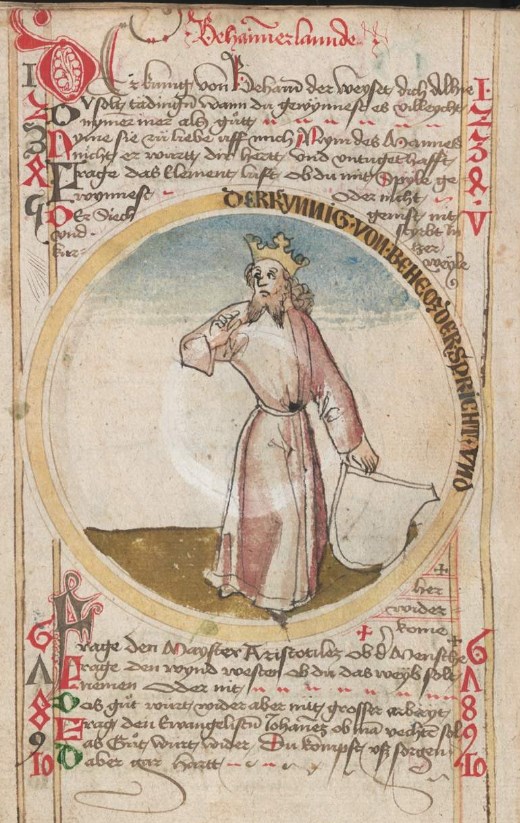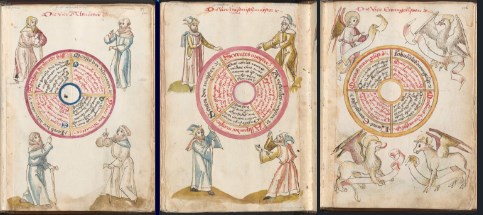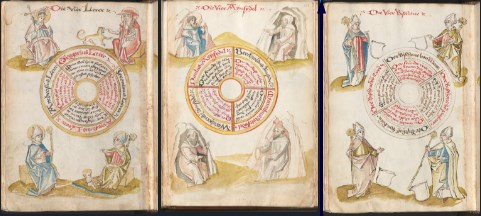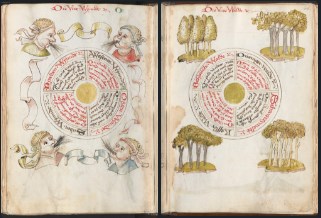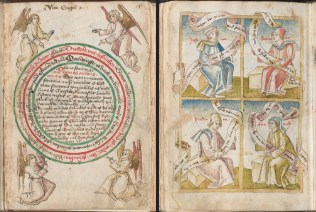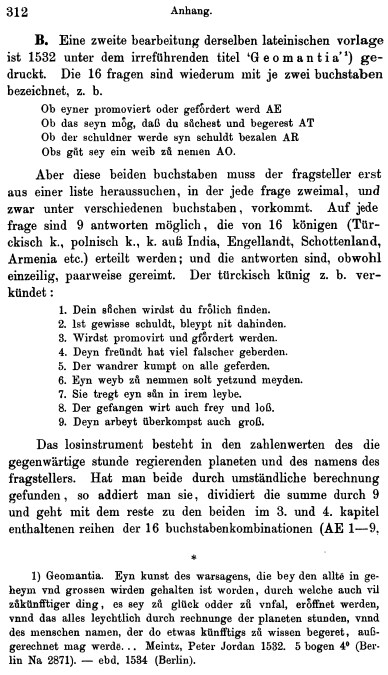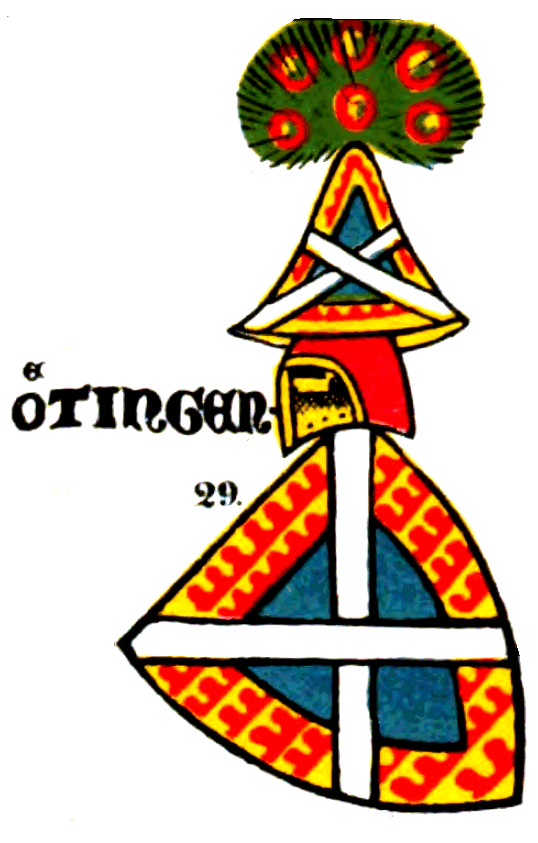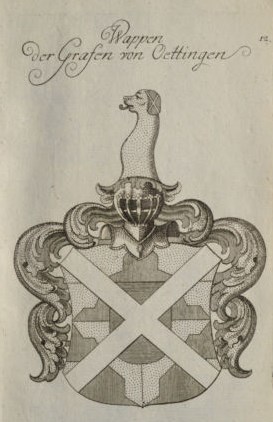Re: The Pope with the donkey / "Oldest Tarot"
Posted: 24 Aug 2014, 23:07
I made a very interesting find.
Cod. Pal. germ. 7
Wahrsagebuch (= lot book)
Bayern, 1. Hälfte 15. Jh.
http://digi.ub.uni-heidelberg.de/diglit ... fc1c30dacc
A lot book based on 32 animals, each with 32 one-line-answers, 32 Prophets (+ 4 additional philosophs), 32 questions or themes.
All 22 animals of the Fränkische Losbuch are part of the 32 animals in this text. The row of the animals is confusing, not the same as in the Fränkische Losbuch, with the exception, that Wag = Libra is again the first sign.
10 animals are new, 7 of the them are birds.
The connecting system seems to be rather similar to the Fränkische Losbuch, but again, there are a lot of differences. But it's close enough to state, that both lot books existed not independent from each other.
That's the row (FL stands for Fränkische Losbuch with number of the already known motifs):
01 Wag (zodiac Waage/Libra, FL 1)
02 Gauch oder Guguck (cuckoo, new)
03 Esel (donkey, FL 22)
04 Falck (falcon, new)
05 Nachtigal (nightingale, FL 16)
06 Fuchs (fox, new)
07 Hierß (stag, FL 19)
08 Per (bear, new)
09 Hunt (dog, FL 20)
10 Krebs (zodiac Krebs/Cancer, FL 4)
11 Leb (zodiac Löwe/Leo, FL 5)
12 Junckfraw (zodiac Jungfrau/Virgo, FL 7)
13 Zwihling (zodiac Zwilling/Gemini, FL 10)
14 Visch (zodiac Fische/Pisces, FL 8)
15 Weßrer (zodiac Wassermann/Aquarius, FL 9)
16 Sperwer (sparrowhawk, new)
17 Schutz (zodiac Schütze/Sagitarius, FL 11)
18 Krannich (crane, FL 14)
19 Adler (eagle, FL 15)
20 Hann (cock, new)
21 Taube (pigeon, new)
22 Scorp (zodiac Scorpio, FL 12)
23 Einhorn (unicorn, zodiac Steinbock/Capricorn, FL 13)
24 Awle (Owl, new)
25 Rab (Raven, 13th zodiac sign, FL 6)
26 Wieder (zodiac Aries, FL 2)
27 Ochß (Einhorn, zodiac Taurus, FL 3)
28 Kamel (camel, FL 17)
29 Sitich (parrot, FL 18)
30 Haß (Hare FL 21)
31 Aglaster (bird, Elster = magpie ?, new)
32 Gaiß (goat, new)
Here is the other list (from Fränkische Losbuch)
Two of the animals (animal pages with small animal and 32 lines of text):


4 outside philosophs:

Some of the Prophets:
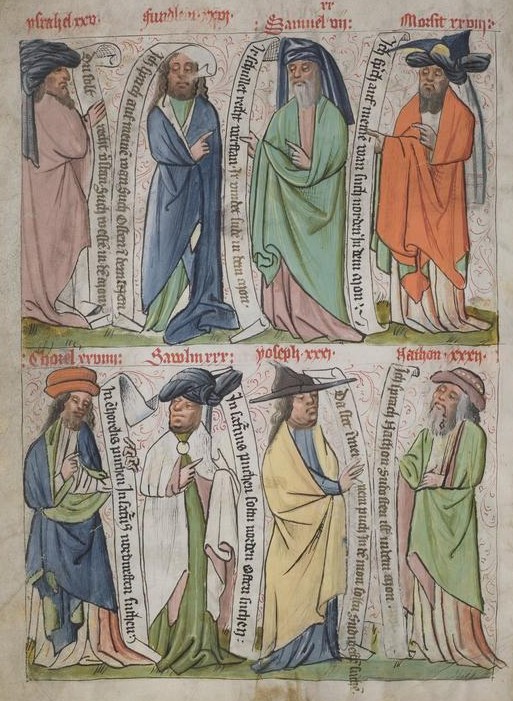
Technical pages (at one I added the 7 connected planets):


Cod. Pal. germ. 7
Wahrsagebuch (= lot book)
Bayern, 1. Hälfte 15. Jh.
http://digi.ub.uni-heidelberg.de/diglit ... fc1c30dacc
A lot book based on 32 animals, each with 32 one-line-answers, 32 Prophets (+ 4 additional philosophs), 32 questions or themes.
All 22 animals of the Fränkische Losbuch are part of the 32 animals in this text. The row of the animals is confusing, not the same as in the Fränkische Losbuch, with the exception, that Wag = Libra is again the first sign.
10 animals are new, 7 of the them are birds.
The connecting system seems to be rather similar to the Fränkische Losbuch, but again, there are a lot of differences. But it's close enough to state, that both lot books existed not independent from each other.
That's the row (FL stands for Fränkische Losbuch with number of the already known motifs):
01 Wag (zodiac Waage/Libra, FL 1)
02 Gauch oder Guguck (cuckoo, new)
03 Esel (donkey, FL 22)
04 Falck (falcon, new)
05 Nachtigal (nightingale, FL 16)
06 Fuchs (fox, new)
07 Hierß (stag, FL 19)
08 Per (bear, new)
09 Hunt (dog, FL 20)
10 Krebs (zodiac Krebs/Cancer, FL 4)
11 Leb (zodiac Löwe/Leo, FL 5)
12 Junckfraw (zodiac Jungfrau/Virgo, FL 7)
13 Zwihling (zodiac Zwilling/Gemini, FL 10)
14 Visch (zodiac Fische/Pisces, FL 8)
15 Weßrer (zodiac Wassermann/Aquarius, FL 9)
16 Sperwer (sparrowhawk, new)
17 Schutz (zodiac Schütze/Sagitarius, FL 11)
18 Krannich (crane, FL 14)
19 Adler (eagle, FL 15)
20 Hann (cock, new)
21 Taube (pigeon, new)
22 Scorp (zodiac Scorpio, FL 12)
23 Einhorn (unicorn, zodiac Steinbock/Capricorn, FL 13)
24 Awle (Owl, new)
25 Rab (Raven, 13th zodiac sign, FL 6)
26 Wieder (zodiac Aries, FL 2)
27 Ochß (Einhorn, zodiac Taurus, FL 3)
28 Kamel (camel, FL 17)
29 Sitich (parrot, FL 18)
30 Haß (Hare FL 21)
31 Aglaster (bird, Elster = magpie ?, new)
32 Gaiß (goat, new)
Here is the other list (from Fränkische Losbuch)
I took some snapshots:1. Ob ains an Wirdigkeit mag komen (question)
If one gets honors (translation of question)
Prophet David (Prophet)
King Franckreich (France) (King)
Animal: Wag - Zodiac: Libra (Animal ... in this case a zodiac sign)
Further attributions: Mercury / North
2. Ob ains gedancken vollend mugen werden
If one's ideas reach their goal
Prophet Daniel
King Engelland (England)
Animal: Wider - Zodiac: Aries
Further attributions: Mercury / West
3. Ob es gut sey wider feynd kriegen
If it is good to fight against an enemy
Prophet Zacharias
King Schottenland (Scotland)
Animal: Ochs - Zodiac: Taurus
Further attributions: Jupiter / East
4. Von frawen haymlichkeit
About "Hamlichkeit" of the woman
Prophet Isaias
King Ungern (Hungary)
Animal: Krebs - Zodiac: Cancer
Further attributions: Jupiter / North
5. Von gottes huld und gnaden
About god's grace
Prophet Abacuck
King Marroch (Marocco)
Animal: Leb - Zodiac: Leo
Further attributions: Mercury / East
6. Von manne haymlickeit
About "Haymlichkeit" of the man
Prophet Jonas
King Cecilien (Sicilia ?)
Animal: Rab - Crow
Further attributions: Mercury / South
7. Von gtrewn Lewten
About loyal persons
Prophet Malachias
King Römischer König (Rome)
Animal Jungfraw - Zodiac: Virgo
Further attributions: Jupiter / South
8. Von vil frawen
About many women
Prophet Jeremias
King Morenland (land of the Moors)
Animal Fisch - Zodiac: Pisces
Further attributions: Venus / East
9. Von reichtum
about richness
Prophet Gedeon
King Armenien (Armenia)
Animal Wassertrager - Zodiac: Aquarius
Further attributions: Mars / North
10. Von langem leben
About long life
Prophet Nabuchodonnsor
King Schweden (Sweden)
Animal Zwyling - Zodiac: Gemini
Further attributions: Jupiter / West
11. Von deinem frewnde
About a male friend
Prophet Ismahelite
King Turcken (Turkey)
Animal Schutz - Zodiac: Sagitarius
Further attributions: Mars / South
12. Von deiner Frewndin
About a female friend
Prophet Theodosius
King Spangen (Spain)
Animal: Scorpion Zodiac: Scorpio
Further attributions: Mars / West
13. Ob es gut sej wallen
If it good to "wallen" (? to wander or to make a pilgrim's journey ?)
Prophet Putifar
King Indian (India)
Animal Einhorn - Zodiac: unicorn/capricorn
Further attributions: Mars / East
14. Ob es gut sey zu Ee greffen
If it good to marry
Prophet Olibrius
King Capodocia (central Turkey, Anatolia)
Animal: Kranch (crane)
Further attributions: Venus / North
15. Ob eins sein schuld vergelten mag
If something is paid back
Prophet Moyses
King Tartern (land of the Tartars ? Mongolia ?)
Animal: Arr (eagle)
Further attributions: Sun /NorthEast
16. Von weisheit und thorheit
About wisdom and stupidity
Prophet Isaac
King Lilio (?)
Animal: Nachtigall (nightingale)
Further attributions: Venus / South
17. Von herren lone
About salary of a master
Prophet Abraham
King Nobie (Nubia)
Animal: Kamelthyer (camel)
Further attributions: Venus / West
18. Von sorgen
About sorrows
Prophet Joseph
King Cypern (Cyprus)
Animal Syttich (parrot)
Further attributions: Moon / SouthEast
19. Ob eins verloren ding wider finde
If a lost object is found again
Prophet Samuel
King Arragon (Aragon)
Animal: Hyrs (stag)
Further attributions: Saturn / West
20. Von hoffnung
About hope
Prophet Israhel
King Babylonien (Babylon)
Animal: Hundt (dog)
Further attributions: Saturn / East
21. Ob ein gefangener erlöst mug werden
If a prisoner will be released
Prophet Nathan
King - Emperor
Animal: Has (Hare)
Further attributions: Saturn / North
22. Von der libe
About love
Prophet Jacob
King - Pope
Animal: Esel (donkey)
Further attributions: Saturn / South
Two of the animals (animal pages with small animal and 32 lines of text):


4 outside philosophs:

Some of the Prophets:

Technical pages (at one I added the 7 connected planets):






